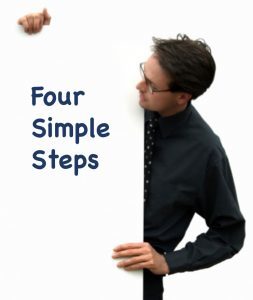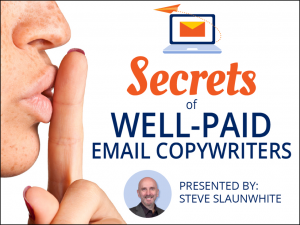Steve Slaunwhite's Blog, page 3
January 24, 2018
How to Plan an Email Follow-up Campaign
 Okay. You’re sitting down to write a series of follow-up emails to those who’ve attended a webinar or downloaded a white paper. You know those emails are key to driving more conversions, so they’ve got to be good.
Okay. You’re sitting down to write a series of follow-up emails to those who’ve attended a webinar or downloaded a white paper. You know those emails are key to driving more conversions, so they’ve got to be good.
What are you going to say in each of those messages?
Obviously, each email can’t be essentially the same. If you merely write seven variations of “buy now”, your conversion rates will plummet.
The good news is, there is a simple way to plan out your email sequence. Here’s how to do it…
Step 1: Start With The Prospect
Imagine you’re the prospect. You’ve just downloaded the white paper or attended the webinar. What are you going to be thinking and feeling? What questions are you going to have? What more do you (as the prospect) need to know in order to take action on the offer?
It’s not enough to merely visualize your prospect or glance at a buyer persona. You really need to get into their moccasins.
When I do this, I go into a lot of detail. I think about whether the prospect is using a mobile device or desktop, whether the prospect is at home or work, whether it’s a weekday or weekend. I think about how busy the prospect is, what their priorities are, and what they’re trying to accomplish, both personally and for their business.
Step 2: Ask Yourself Questions
Next, make a list of questions prospects are likely asking themselves after the initial lead-generating event (i.e. webinar, white paper download, etc.)
For example, say your business provides high-end coaching and you’re using a webinar to generate leads. Your offer is for a free “30-minute coaching session”. Once the webinar is over, what questions are participants likely to be asking themselves?
Here are my guesses:
I have follow-up questions? Can I get help?
How much does it cost? Is the cost worth the benefits?
Why now? What’s the urgency? Why is it important to take advantage of this free coaching session, today.
What do your clients say about your services? What bottom-line results did they see?
I’m not sure if this is for me. How do I make that determination?
How are you different from other coaching businesses? Why you?
What happens during the 30-minute coaching session? How will it benefit me?
Once you’ve jotted down these questions, you can start to see a buyer’s journey emerging. Now it’s time to nail that down, which is our next step…
Step 3: Arrange Those Questions Into a Buyer’s Journey
What’s the first step for the prospect? Well, prospects likely have follow-up questions after a webinar or white paper download, so that’s ideal content for the first email. Pricing is typically a question that comes up when prospects are at the tipping point of “buy or not buy”, so the best place for that email is near the end.
You get the idea. Here’s an example of a possible sequence based on anticipating the buyer’s journey:
I have follow-up questions? Can I get help?
What happens during the 30-minute coaching session? How will it benefit me?
I’m not sure if this is for me. How do I make that determination?
How are you different from other coaching businesses? Why you?
What do your clients say about your services? What bottom-line results did they see?
How much does it cost? Is the cost worth the benefits?
Why now? What’s the urgency? Why is it important to take advantage of this free coaching session, today.
Once you’ve done this, you’re ready for the final step…
Step 4: Create a simple theme for each email
Now you can decide what topic you’re going to focus on for each email in the sequence. Here’s an example…
Email #1: Got questions? Here’s how to get answers.
Email #2: What happens during your 30-minute coaching session?
Email #3: Is our coaching program for you? Take the quiz…
Email #4: 3 important ways our coaching is different.
Email #5: How our coaching client, Lisa Smith, doubled her team’s productivity. (And got a promotion!)
Email #6: Will coaching be worth your investment?
Email #7: Last chance. Spots of filling. Waiting list has begun.
This four-step approach — imagine, questions, arrange, themes — takes the guesswork out of putting together an email sequence. It also results in higher conversion rates.
Try it the next time you’re writing follow-up emails for a white paper/ebook download and lead-gen webinar.
The post How to Plan an Email Follow-up Campaign appeared first on Steve Slaunwhite.
December 6, 2017
Why it pays to say “Thanks” in an email marketing piece
I recently came across a survey, by BoomerangApp.com, which showed that closing an email with some sort of “Thanks” will boost response rates. In fact, “Thanks in advance” did a little better than “Thanks” or simply “Thank you”. (By the way, “Best” scored the lowest.)
 Was I surprised by these results? A little. But not that much.
Was I surprised by these results? A little. But not that much.
As a copywriter, I’ve long understood the power of weaving appreciation into your marketing copy. The more prospects and customers feel you value them, the more responsive they’ll be to your emails, landing pages, ads and other marketing pieces.
I’m sure there are some psychological principles at play here. But what I suspect it comes down to is this: “Thanks” closes the gap; the gap between you and your prospects.
Think about what happens when a total stranger says thank you to you. Don’t you feel in that moment, perhaps just for a fleeting second, that you’re not strangers anymore?
When you’re marketing, you want to achieve that kind of connection. And, whoa, it ain’t easy these days! So a simple thank you can go a long way.
That’s the great thing about this technique. You don’t have to fake it. If you’re a business owner or marketer, you do appreciate your prospects and customers. Very much. You’d be a fool not to. So demonstrating that in your marketing copy isn’t merely a response-boosting trick-of-the-trade, it’s a sincere and authentic thing to do.
So let’s talk tactics. How do you do this when writing copy and content?
As the Boomerang survey indicated, in the marketing writer’s lexicon of power words “thanks” ranks right up there with “you” and “free”. So take advantage of any opportunity to say it — or words like it — in your copy. You can do that in the closing of emails, in direct mail letters, and in key places on your website.
But you don’t always have to use that word. (A website littered with thank yous would be tiring!) There are other ways to show appreciation. Here are a few examples of copy starter lines:
What we enjoy most about working with our Realtor clients is…
Congratulations to our client in Vancouver who just reached an important milestone…
Here’s a customer success story we couldn’t wait to share with you…
Nothing puts smiles on our faces more than when a customer…
We’re on your side when it comes to…
We couldn’t do it without you because…
So weave in a few “thanks” into your marketing messages. If you do, your prospects and customers will naturally become more engaged — and respond accordingly.
The post Why it pays to say “Thanks” in an email marketing piece appeared first on Steve Slaunwhite.
Why is pays to say “Thanks” in an email marketing piece
I recently came across a survey, by BoomerangApp.com, which showed that closing an email with some sort of “Thanks” will boost response rates. In fact, “Thanks in advance” did a little better than “Thanks” or simply “Thank you”. (By the way, “Best” scored the lowest.)
 Was I surprised by these results? A little. But not that much.
Was I surprised by these results? A little. But not that much.
As a copywriter, I’ve long understood the power of weaving appreciation into your marketing copy. The more prospects and customers feel you value them, the more responsive they’ll be to your emails, landing pages, ads and other marketing pieces.
I’m sure there are some psychological principles at play here. But what I suspect it comes down to is this: “Thanks” closes the gap; the gap between you and your prospects.
Think about what happens when a total stranger says thank you to you. Don’t you feel in that moment, perhaps just for a fleeting second, that you’re not strangers anymore?
When you’re marketing, you want to achieve that kind of connection. And, whoa, it ain’t easy these days! So a simple thank you can go a long way.
That’s the great thing about this technique. You don’t have to fake it. If you’re a business owner or marketer, you do appreciate your prospects and customers. Very much. You’d be a fool not to. So demonstrating that in your marketing copy isn’t merely a response-boosting trick-of-the-trade, it’s a sincere and authentic thing to do.
So let’s talk tactics. How do you do this when writing copy and content?
As the Boomerang survey indicated, in the marketing writer’s lexicon of power words “thanks” ranks right up there with “you” and “free”. So take advantage of any opportunity to say it — or words like it — in your copy. You can do that in the closing of emails, in direct mail letters, and in key places on your website.
But you don’t always have to use that word. (A website littered with thank yous would be tiring!) There are other ways to show appreciation. Here are a few examples of copy starter lines:
What we enjoy most about working with our Realtor clients is…
Congratulations to our client in Vancouver who just reached an important milestone…
Here’s a customer success story we couldn’t wait to share with you…
Nothing puts smiles on our faces more than when a customer…
We’re on your side when it comes to…
We couldn’t do it without you because…
So weave in a few “thanks” into your marketing messages. If you do, your prospects and customers will naturally become more engaged — and respond accordingly.
The post Why is pays to say “Thanks” in an email marketing piece appeared first on Steve Slaunwhite.
April 13, 2016
The NEW high-paying copywriting projects
When I set up my copywriting business back in the ’90s, I was frustrated by how much I was able to charge to write a press release. Despite its high value — remember, press releases actually worked back then — the most I could get was about $400. And some clients wanted to pay far less than that.
Whatever the reasons, it was a low-paying gig.
There was no point in fighting it. No amount of convincing would get clients to value these workhorses of public relations any more than they did. It was just the way it was.
So I did what any self-respecting freelancer would do. I focused on other types of projects that paid much better: direct mail, ads, annual reports, and articles.
Today, the world of copywriting has changed. (To put it mildly!) What paid well a few years ago in some cases pays peanuts today. And a new slate of copywriting projects has emerged where the fees range from professionally-respectable to very high.
So what are those new darlings of copywriting? Here’s my list.
1. Websites
Website writing has been a roller-coaster ride. First, it paid well. Then, it didn’t. Now companies are willing to invest in good website writing again.
Why? I suspect it’s because so many companies are upgrading to responsive design and, as a result, taking a closer look at their websites. They want better branding and storytelling; more compelling messaging; and more leads, enquiries and conversions.
And that requires a skilled messaging strategist and writer. (That’s us.)
2. Email Marketing
Word for word, email copywriting is one of the best-paying specialities these days. And for good reason. Companies are constantly looking for ways to get better results with their e-newsletters, follow-up emails and email marketing campaigns.
Any writer who can help them do that will be in high demand.
3. White Papers & Ebooks
There are so many of these things on the internet, you’d think they don’t work anymore. But they do. A great white paper, for example, can build thought-leadership, position a company as go-to experts and innovators, generate leads, get publicity, spur sales, and more.
That’s why so many companies are willing to invest serious dollars in this content.
4. Sales Pages
These are web pages designed to make a sale. If it has a Buy Now button or similar call-to-action, it’s a sales page.
This type of project pays well for an obvious reason. The better it’s written, the more leads, sales, registrations, sign-ups, etc. a company gets. Anytime you can write copy that makes money for a client, you can charge accordingly.
5. Naming
You could argue that naming isn’t copywriting. But I disagree. I think anything that involves coming up with the right marketing/selling words is copywriting. Even if it’s just one word.
I’ve developed numerous product names, and even new business names, for clients. These are fun projects, but a lot more work than you might think. It takes hours of strategizing, brainstorming, and long walks hoping for lightening to strike to come up with a terrific, brand-worthy name.
So that’s my list. Did I miss anything? Probably. If you’d like to add your two cents to this list, I’d love to hear from you. You can use the comment section below.
The post The NEW high-paying copywriting projects appeared first on Steve Slaunwhite.
April 23, 2015
4 Surprising Traits Clients Want in a White Paper Writer
 I had an opportunity recently to interview some clients about their experience with white paper writers. (As well as those who write special reports, ebooks, and other types of “long form” content.) The results were interesting — to say the least.
I had an opportunity recently to interview some clients about their experience with white paper writers. (As well as those who write special reports, ebooks, and other types of “long form” content.) The results were interesting — to say the least.
Much of what these clients said didn’t surprise me. For example, they were unanimous that “meeting deadlines” was a desirable trait. However, there were a few characteristics they emphasized that I didn’t expect to hear.
So if you write white papers — or are thinking of getting into this niche — take a look at the list below. These are traits you may not have realized are so important to clients. (I didn’t.)
1. A fan of white papers.
This is the trait that surprised me the most. Many clients I spoke to preferred to work with writers who have a demonstrated interest in white papers. As one client put it, “I want a writer to be a fan, to read white papers, to have an opinion as to which ones are great. And why.”
That makes sense. After all, there’s a reason Stephen King writes suspense. He’s a fan of the genre.
White papers, too, is a genre. So if you’re going to craft these documents, read them. Study them. Become an aficionado.
2. A strategist.
Almost unanimously, clients told me they want a writer who can strategize the development of a white paper. That means collaborating with the client to develop the topic and approach, dream up a great title, and basically be the brains behind the piece.
Strategist. And writer.
One client put it this way, “I don’t want a writer who needs detailed direction and hand-holding. I want to be able to brainstorm with him, get his advice, and then let him take the ball and run with it.”
3. Curiosity.
Another trait clients want to see is curiosity about the white paper topic. “I want to get a sense that the writer is as enthusiastic and curious about our innovative approach to training as we are,” said one client, CEO of a sales training firm.
Obviously, if you can’t summon much interest in the topic, you’re not going to be able to write about it persuasively and authoritatively. (The twin pillars of a great white paper.)
That’s why, as a marketer and copywriter, I focus on industries that fascinate me.
4. Recommend visuals.
This has become an important skillset of white paper writers in recent years. Content is becoming more visual — simply because there are more visual learners — and, although clients recognize you’re not a designer, they do want you to contribute ideas for photos, charts, graphs, infographics, etc.
For example, I just finished writing a special report for a client where I recommended including two graphs and an infographic. He thanked me for the suggestions.
So there you have it. Four surprising (at least to me) traits of a great white paper writer. If you craft this type of content, be sure to demonstrate that you’re a fan, a strategist, curious, and able to recommend visuals.
Because if you read this far, you probably are.
—————
The post 4 Surprising Traits Clients Want in a White Paper Writer appeared first on Steve Slaunwhite.
April 9, 2015
What’s the Best Topic for a White Paper?
 I got a somewhat desperate call from a CEO the other day. “We want to get a white paper done,” he explained, “but there are so many out there. How do we come up with a topic that’s going to stand out?”
I got a somewhat desperate call from a CEO the other day. “We want to get a white paper done,” he explained, “but there are so many out there. How do we come up with a topic that’s going to stand out?”
Good question.
The topic of your white paper is crucial. Get that right and there’s an excellent chance you’ll end up with a marketing piece that’ll boost thought-leadership, leads and sales. Get the topic wrong, however, and – ouch! – you’ll have squandered hours and dollars on something that’s more akin to a white elephant than a white paper.
Fortunately, there’s a proven criteria for selecting an ideal topic. Here it is…
Criterion #1. The topic must be “high interest” to your prospects
The topic of your white paper needs to be so relevant and helpful that prospects will drop what they’re doing, fill out the request form, and download that baby right away.
What does “high interest” mean?
For some prospects, it means solid information that helps them make a buying decision. For example, if your new line of forklift trucks has a fancy technology that makes them safer, then a prospect will want to be convinced before buying. He will not want to make a six-figure purchasing mistake!
By the way, just because a technology is new and innovative doesn’t necessarily mean prospects will be interested. You need to position that technology as a big benefit. For example, “Lowering Insurance Costs With COB Forklift Technology.”
Of course, a white paper isn’t always about the marvels of a new technology or innovation. Sometimes it’s more “how to” in nature. Say, for example, your company trains real estate professionals in selling skills. A high interest topic for a white paper might be, “A 7-Step System for Getting More Listings on Facebook.”
Criterion #2. The topic must position your company as the best solution
There’s a joke I tell in workshops about a company that created a white paper on getting cheap vacations in the Bahamas. The company is a management consulting firm. Was that topic of high interest to their prospects? Perhaps. But it had nothing to do with what the company offers! (Had they been a travel agency however…)
You want your white paper to ultimately lead to your product or service being positioned in the prospect’s mind as the best solution. So the topic must be the kick-start of that journey.
For example, if your product is a software that helps industrial workplaces comply with health and safety regulations, don’t create a white paper on time management! Sure, that topic may interest your prospects — busy warehouse directors – but it won’t tie back to your product. A better topic might be: 5 Keys to Cutting Downtime by 18%.
Yes, getting the topic right takes some brainstorming and evaluating… and then brainstorming some more. But the effort is worth it. Just remember: you can never create a winning white paper on a poor topic, no matter how hard you try.
The post What’s the Best Topic for a White Paper? appeared first on Steve Slaunwhite.
February 19, 2015
How to Write a Sales Email That Works
 Chances are, you receive dozens of “sales emails” in your inbox each day. You ignore most of them for a myriad of reasons: too long, too spammy, I-don’t-know-this-guy, boring, not relevant to me, hyped-up drivel, and so forth.
Chances are, you receive dozens of “sales emails” in your inbox each day. You ignore most of them for a myriad of reasons: too long, too spammy, I-don’t-know-this-guy, boring, not relevant to me, hyped-up drivel, and so forth.
That should give you an idea of what you’re up against when you need to craft a email to a prospect, client or customer.
So how do you write one that works? (Gets opened, gets read, gets acted upon.)
As someone who does this for a living, I wish the process were mysterious and complex — like brain surgery. The truth is, writing a persuasive email that gets the job done is remarkably simple.
It’s all in the prep.
Simply start by asking yourself these three “prep questions”:
What do I want to say?
Why is this important to the prospect?
What “next step” do I want the prospect to take?
Say, for example, your company offers a bookkeeping service for veterinary clinics. You’ve got some hot leads you want to follow-up on. So you decide to send each an email to, hopefully, get them to set up an initial phone meeting with you.
Here’s how you would use the prep questions above to write that email…
What do you want to say? Your answer might be: 1) Thank you for downloading the report. 2) Our bookkeeping service is exclusively for veterinarian clinics. 3) The number one benefit of our service is faster cash flow due to better insurance billing bookkeeping and management.
So now that you’ve figured out what to say, can’t you just say it and be done with it? Many sales emails do, and that’s why they fail. Merely stating your message isn’t enough to gain the attention and interest of the prospect. That’s why the second prep question is so crucial…
Why is this important to the prospect? Your answer might be: 1) According to Vet Practice Journal, poor insurance billing bookkeeping is one of the top five reasons clinics struggle with cash flow. 2) Our service solves that problem.
That second question is harder to answer because it often takes some thinking and strategizing on your part. You have to put yourself in the prospect’s shoes.
The final prep question is, “What next step do you want the prospect to take?” Your answer might be: 1) A quick 15-minute discovery phone call to learn about our bookkeeping service. 2) Which of the following dates and times work for you?
Once you have those three prep questions answered, congratulations. You now know what to say, why it matters to the prospect, and what you want your prospect to do. Those are the key ingredients of a winning sales email.
Of course, now you need to actually write the thing. But because you’ve answered the prep questions, the email practically writes itself. (Well, almost!)
The post How to Write a Sales Email That Works appeared first on Steve Slaunwhite.
January 7, 2015
How To Write Faster Than a Superhero
 Confession: I’m a fan of the superhero The Flash.
Confession: I’m a fan of the superhero The Flash.
If you’re at all familiar with comic book lore, you know that this is the guy who runs super, super fast. Why am I a fan? There’s something about being able to go “zoom” and you’re “there” — in seconds — that somehow appeals to me.
Yet, despite his talent for sprinting faster than a Hennessey Venom, I’m fairly certain that The Flash can’t write any speedier than the rest of us.
In fact, he would probably appreciate getting some practical tips on writing faster, more easily, and with a lot less stress.
So, with that in mind, here are some strategies that have helped boost my writing productivity. Some of these may work for you, even if you’re not a superhero.
1. Create a “tent pole” outline
Forget about the detailed, paragraph-by-paragraph outline your grade eight teacher taught you to create. In my experience, that just makes the writing process longer. Instead, simply make a list of points you want to make in roughly the order you want to make them in. These are your “tent poles”.
Trust me. They’ll make the actual writing a lot easier.
2. Write and polish your opening first
I spend a lot of time crafting the headline and opening few sentences. Once I have those in place, I find that the rest of the article, web page, sales letter, or whatever it is I’m writing, comes together quickly.
Writing and polishing your opening is like pulling the starter cord on a lawnmower. It revs things up and gets things moving. Just having that finished opening in place creates a momentum that makes writing the rest of the piece much faster.
3. Write a crap draft
After writing and polishing your opening, write the rest of the piece as fast as you can — without a care in the world as to how it sounds. In fact, expect your first draft to be awful and, in some areas, nonsensical.
As you’re writing, don’t judge. Don’t edit. Don’t go back and fix anything. Just keep moving forward. If you can’t think of the right word or phrase, insert a bad one. If you can’t dream up a decent metaphor or an example, put [example here] or [metaphor here] and then move on.
Yes, some of what your write will be a useless mess. However, some of it will also be great. The key is to let your ideas flow freely until you have a rough draft in place. Once that’s done, the pressure’s off.
4. Try writing in bullets
My friend, Jim, was struggling to write a sales page for a new program he was launching. He was getting nowhere. So I suggested he simply create a bullet list of what he wanted to say and in roughly the order he wanted to say it in.
Once he did that, he was able to quickly turn those bullets into finished copy. The bullets were essentially a rough draft in disguise.
I know a lot of people who write their rough drafts as bullets. Bullets are less intimidating than crafting sentences and paragraphs, and are quick to write. I even know someone who writes her rough drafts in PowerPoint. Hey, whatever works!
5. Try the Q&A technique
Here’s another method for getting your rough draft done. Turn your writing project into a list of questions – and then answer them.
Say, for example, you’re writing your website ABOUT page. The questions you might want to address are:
What do you do?
What makes you different?
What are your credentials?
Why do you love what you do?
What do clients say they like most about working with you?
You simply answer those questions and, voila, you have a rough draft. Later, you can turn those Q&As into more traditional copy. Or, leave it as a Q&A.
6. Incubate
There are few things more frustrating than getting stuck when trying to write something. You bang your head on the desk trying to dream up a decent headline, but all you get is a headache. Or a particular paragraph won’t come together, no matter how long you hack away at it.
When that happens, stop. Set the writing aside for a few minutes or, if possible, an hour or two. Then go back to it. When you do, I can almost guarantee the right words will suddenly come to you.
Writing productivity experts call this incubation. I’m not sure why it works. I’m just glad it does.
7. Silence your inner editor
You write a sentence. Something tells you it’s not quite right. You go back and change it. You start the next sentence. Then you delete both of them and start again. And on it goes.
Writing like that is like driving in stop and go traffic. It’s slow and agonizing.
To write quickly, you have to turn off your inner editor, at least until your first rough draft in done. Then you can turn that editor loose, and let him or her fix, revise and polish to perfection.
So those are seven ideas for writing more quickly and with less stress. If you have any additional tips on cranking out copy faster than a superhero, please let me know. I’ll share this with my friend The Flash.
The post How To Write Faster Than a Superhero appeared first on Steve Slaunwhite.
November 4, 2014
4 Simple Cures for Boring Marketing Copy
 I actually nodded off once while reading a company’s marketing copy. Granted, I was tired at the time, having already reviewed about a gazillion copywriting examples that day. Still, if the writer had attempted to make the copy just a tad more interesting — rather than same ol’ same ol’ — I would have stayed engaged.
I actually nodded off once while reading a company’s marketing copy. Granted, I was tired at the time, having already reviewed about a gazillion copywriting examples that day. Still, if the writer had attempted to make the copy just a tad more interesting — rather than same ol’ same ol’ — I would have stayed engaged.
Boring copy loses sales. Everyone is too busy these days to pay attention to dull, yawn-inducing emails, websites, landing pages and other content. The good news is, it doesn’t take much of an extra effort to make your marketing copy more interesting. Even absorbing.
Here are four simple ways to do that.
1. Use stories, examples, scenarios.
Stories captivate us. It’s human nature. You’re more likely to be interested in, and remember, a story than even the most compelling presentation of the facts.
That’s why I began this article with a story.
In marketing copy, a story (or an example or a scenario) is handy when you want to switch on the prospect’s mental movie projector so she can visualize how a product will benefit her. Think about it. Don’t you imagine what it’s going to be like driving a new car before you buy it?
So when you’re writing marketing copy and it’s beginning to sound dull, start the next sentence with “For example…” or “Imagine this…” or “Here’s how this would look in your business…” Your copy will immediately liven.
2. Dream up fresh ways to describe things.
One of the traps people fall into when writing copy is describing things — like product features — in much the same way they always have. Or, worse, in much the same way their competitors do.
It’s easy to describe a project management software, for example, with the sentence, “Keeps your To-Dos in front of you so nothing falls through the cracks.” But prospects have heard that line, or something similar, many times before. It’s monotonous.
The challenge in copywriting is to come up with fresh ways to explain things. And that doesn’t take a Herculean effort. Sometimes adding a new twist or variation is all you need to do.
Recently, I came across the website of a data communications expert (Kathy Rowell). On her homepage she describes the problem she solves for clients in this way:
Healthcare data, information and evidence are coming at your organization faster than text messages to a 14-year old’s smartphone.
Adding that one metaphor makes her entire home page not only effective, but unforgettable.
3. Keep it crisp.
Have you ever had a conversation with someone who droned on and on? Not fun. You probably looked for the first opportunity to excuse yourself. “Ah, where’s the washroom?”
The same thing can happen in your marketing copy. It can “drone on”, too. Prospects have no time to dig through a haystack of unnecessary words to get your message. So you need to be a tough editor (aka trimmer.) Cutting even just one unnecessary word can give your copy more momentum.
At a writing workshop I attended years ago, the instructor advised us to, “Know the point you want to make. Make it well. Move on.” Good advice for writing tight, focused copy.
4. Make it about them.
What are prospects more interested in? Your product? Or their own problems, needs and goals?
The answer is obvious. So if you want to make your copy “un-boring” the simplest way to do that is to keep it focused on the prospect.
Yes, you do need to talk about your product, service or offer, but position that as a conversation about how it benefits the prospect.
You will know you’re crafting prospect-focused copy when you find yourself using the words “you” and “your” a lot. In fact, they are arguably the most motivating words in marketing.
So there you have it. Four simple tips for cranking up the interest level in your marketing copy. Advertising legend David Ogilvy once said, “You can’t bore people into buying your product.” I would add, “Don’t even try.”
The post 4 Simple Cures for Boring Marketing Copy appeared first on Steve Slaunwhite.
August 1, 2014
How to Double the Effectiveness of Testimonials
Do you have glowing client testimonials on your website and in other marketing materials? If so, great! But are prospects actually reading those testimonials? Or just looking at them?
I just published an article on my other blog (at the Copywriting Training Center) on this topic. It describes four practical ways to get more of your testimonials read.
You can read that article here.
Enjoy!



